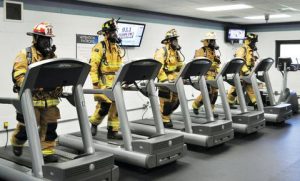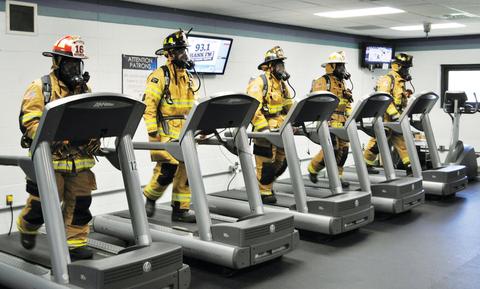National Firefighter Safety Stand Down
Cardiovascular Health & Safety
It has been proven that cardiovascular events take more lives than any other physical factor for firefighters on and off-duty. To reduce these deaths, there are several areas to consider and steps that can be taken. First, let us identify the contributing components to cardiovascular events for firefighters, these include: exposure to fire smoke, rapid deployment from rest to ready when the alarm goes off, heat stress or dehydration, physical exertion, sleep disruption, and coronary artery disease.

Captain Michael Goole, Firefighters Brad Davis and Jeff Lee, Station Chief Stephen Jessup and firefighter Michael Patterson are first on the treadmills during the June 15 Air Management Challenge.
We understand that fire smoke is a complex mixture of heated gases, vapors, and particulate matter. The composition of the smoke is determined not only by the fuel source, but also by fire conditions. While hundreds of decomposition products are found, two of the more common and well-known gases with cardiovascular effects are carbon monoxide and hydrogen cyanide. Carbon monoxide, a by-product of incomplete combustion, is present in virtually all fire environments. A number of studies have quantified a fire fighter’s exposure during various phases of fire suppression. High concentrations of carbon monoxide have been documented not only during knockdown, but also during overhaul when fire fighters may tend to remove their self-contained breathing apparatus (SCBA). If inhaled, carbon monoxide disrupts the blood’s transport of, and intracellular use of, oxygen. The resulting hypoxia can cause myocardial injury. Hydrogen cyanide is formed during the incomplete combustion of substances containing carbon and nitrogen. Hydrogen cyanide frequently has been detected in structure fires, and levels have been shown to exceed established exposure limits. Like carbon monoxide, hydrogen cyanide disrupts the intracellular use of oxygen, resulting in intracellular hypoxia with cardiac manifestations.
It is understood that firefighters are expected to rapidly deploy to the incident scene. Firefighters react to these emergency calls with an increase in their heart rates, probably due to a surge in sympathetic nervous system activity (e.g. the flight or fight response). The increase in heart rate frequently persists through the course of fire suppression activities; a finding not surprising given the heavy physical demands of structural firefighting. A pattern of sedentary periods interrupted by catecholamine surges and heavy physical exertion has been suspected to put firefighters at increased risk for acute heart attacks. Epidemiologic studies in the general population report that heavy physical exertion sometimes immediately precedes and triggers the onset of acute cardiac events.
Heat stress and heat illnesses are well recognized hazards of firefighting. Fire suppression can increase body temperature resulting in sweating and fluid loss, which can cause serum electrolyte changes, lower cardiac stroke volume (the volume of blood pushed during each contraction of the heart), or lower cardiac output. Heat stroke has been reported to increase the risk of myocardial ischemia, arrhythmias, and conduction abnormalities.
To reduce heart attacks and the risk of sudden cardiac events among fire fighters, every firefighter needs to recognize the importance of wearing respiratory protection during all phases of firefighting – from initial attack through overhaul. Tampa Fire Rescue (TFR) provides annual medical evaluations and ensures that the physician conducting the annual medical examinations are knowledgeable about the physical demands of firefighting, the essential job tasks of firefighting, and the consensus guidelines developed by the fire service [NFPA]. TFR has a comprehensive wellness/fitness program for firefighters to reduce risk factors for CVD and improve cardiovascular capacity. However, it is important to remind emergency department personnel and medical professionals to perform carboxyhemoglobin testing for any firefighter that experiences a cardiac event on a fire scene.
During fire suppression and training operations, it is advisable to control exposure to carbon monoxide and other fire contaminants through proper management of the fire scene and proper use of respiratory protection. Providing on-scene rehabilitation to monitor vital signs for indication of excessive cardiovascular strain, and to cool and hydrate the fire fighter, is very effective in mitigating risk.
The personal commitment of each firefighter to engage in one’s own steps for cardiovascular health cannot be over-emphasized. While I truly believe it is the character of heart that makes a great firefighter, the care of each Tampa Firefighter’s physical heart is of vital importance. The following measures can be taken to effectively decrease your risk:
- Choose good nutrition
- Manage high blood cholesterol
- Maintain a healthy blood pressure
- Be physically active every day
- Aim for a healthy weight
- Manage diabetes
- Reduce your off-duty stress
For additional tips on implementing any of the health measures above, please contact your Tampa Fire Rescue Occupational Health Office. We are here to help, and we care about your heart.
Stay Safe,
Tiffany
Tiffany Kline, R.N., C.O.H.N.
Occupational Health Nurse Supervisor, Tampa Fire Rescue
City of Tampa / 116 S. 34th Street / Tampa, FL 33605
p: (813)242-5393 / c: (813)310-0736 / [email protected]


